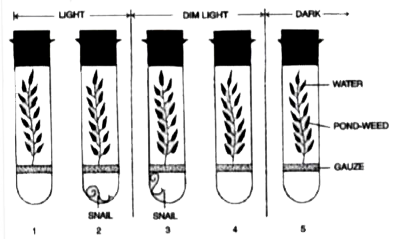In a wheat field, some broad leaved weeds were seen by a farmer. Which plant hormone would you suggest to get rid of them?
Step by step video & image solution for In a wheat field, some broad leaved weeds were seen by a farmer. Which plant hormone would you suggest to get rid of them? by Biology experts to help you in doubts & scoring excellent marks in Class 10 exams.
Updated on:21/07/2023Topper's Solved these Questions
Similar Questions
A gardener finds some broad leaved dicotweeds growing in his lawns what can be done to get rigd of the weeds efficiently?
View SolutionThe diagram given below is a set up to demonstrate an experiment

Pond-weed was placed in five water-filled tubes. The experiment was set-up as shown in the diagram. The tubes were then left for 24 hours
In which tube would you expect to find the plant with the least amount of starch?
View Solution
Knowledge Check
A farmer grows cucumber plants in his field. He wants to increase the number of female flowers in them. Which plant growth regulator can be applied to achieve this?
AABABEthyleneCGADCytokininsRead the passage given below, and answer the questions that follow:
Some students wanted to investigate the pattern of inheritance of flower colour in snapdragon. They selected some plants which were homozygous for red flowers and some other plants which were homozygous for white flowers. These plants were labelled as Parental Plants (P1). These plants (red-flowered and white flowered), were cross-pollinated. The seeds obtained from these plants were planted in a separate field. These seeds germinated to produce the plants which were labelled as the plants of F1-generation.
Based on the above experiment, answer the following questions:
Select the statement which correctly predicts the phenotype of the plants of F1 generation.AAll the plants will bear red flowersBAll the plants will bear white flowersC50% plants will bear red flowers and 50% will bear white flowersD100% plants will bear pink flowers.Read the passage given below, and answer the questions that follow:
Some students wanted to investigate the pattern of inheritance of flower colour in snapdragon. They selected some plants which were homozygous for red flowers and some other plants which were homozygous for white flowers. These plants were labelled as Parental Plants (P1). These plants (red-flowered and white flowered), were cross-pollinated. The seeds obtained from these plants were planted in a separate field. These seeds germinated to produce the plants which were labelled as the plants of F1-generation.
Based on the above experiment, answer the following questions:
If the plants of F1-generation are allowed to self-pollinate, then in F2-generation.AAll of the resulting plants will have pink flowers.B75% plants will have red flowers and the remaining 25% plants will have white flowers.C25% plants will have red flowers, 25% plants will have pink flowers and 25% will have white flowers.D25% plants will have red flowers and the remaining 75% plants will have white flowers.
The diagram given below is a set up to demonstrate an experiment

Pond-weed was placed in five water-filled tubes. The experiment was set-up as shown in the diagram. The tubes were then left for 24 hours
In which tube would you expect the greatest increase in dry weight to the pond-weed
View SolutionA farmer grows cucumber plants in his field .He wants to increase the number of female flowers in them. Which plant growth regulator can be applied to achieve this?
View SolutionRead the passage given below, and answer the questions that follow:
Some students wanted to investigate the pattern of inheritance of flower colour in snapdragon. They selected some plants which were homozygous for red flowers and some other plants which were homozygous for white flowers. These plants were labelled as Parental Plants (P1). These plants (red-flowered and white flowered), were cross-pollinated. The seeds obtained from these plants were planted in a separate field. These seeds germinated to produce the plants which were labelled as the plants of F1-generation.
Based on the above experiment, answer the following questions:
The genotypic ratio of the plants of F2-generation will be:
View SolutionRead the passage given below, and answer the questions that follow:
Some students wanted to investigate the pattern of inheritance of flower colour in snapdragon. They selected some plants which were homozygous for red flowers and some other plants which were homozygous for white flowers. These plants were labelled as Parental Plants (P1). These plants (red-flowered and white flowered), were cross-pollinated. The seeds obtained from these plants were planted in a separate field. These seeds germinated to produce the plants which were labelled as the plants of F1-generation.
Based on the above experiment, answer the following questions:
This type of inheritance can be described as:
View SolutionRead the passage given below, and answer the questions that follow:
Some students wanted to investigate the pattern of inheritance of flower colour in snapdragon. They selected some plants which were homozygous for red flowers and some other plants which were homozygous for white flowers. These plants were labelled as Parental Plants (P1). These plants (red-flowered and white flowered), were cross-pollinated. The seeds obtained from these plants were planted in a separate field. These seeds germinated to produce the plants which were labelled as the plants of F1-generation.
Based on the above experiment, answer the following questions:
The biological name of snapdragon is:
View Solution
